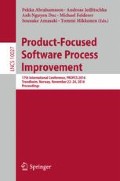Abstract
In software development projects, documents are very important for sharing requirements and other information among employees. However, information can be transported in different ways. Conversations, meetings, workshops and emails convey and impart information as well. Especially large companies struggle in dealing with unclear and incorrect information flows. These information flows can be improved by means of information flow analysis and flow patterns. One technique to analyze information flows is the FLOW method. It supports visualization and analysis of information flows to detect lacks and anomalies and thereby improves information flows. An analyst gathers information transported in the company. Afterwards, information flows are visualized and analyzed based on patterns and personal experience. Nevertheless, analysis based on individual knowledge is error-prone. Hence, we improve the FLOW method with the help of social network analysis applying centrality measures to the FLOW method and to support the FLOW analyst.
Access this chapter
Tax calculation will be finalised at checkout
Purchases are for personal use only
Notes
- 1.
Refer to [16] for a detailed description of the FLOW syntax.
- 2.
UCINET is a common used tool for social network analysis.
References
Stapel, K.: Informationsflusstheorie der Softwareentwicklung, 1st edn., Univ, Hannover, Dr. Hut, München (2012)
Stapel, K., Knauss, E., Schneider, K.: Using FLOW to improve communication of requirements in globally distributed software projects. In: Workshop on Collaboration and Intercultural Issues on Requirements: Communication, Understanding and Softskills (CIRCUS 2009), pp. 5–14 (2009)
Durugbo, C., Tiwari, A., Alcock, J.R.: Modelling information flow for organisations: a review of approaches and future challenges. Int. J. Inf. Manag. 33(3), 597–610 (2013)
Merrill, J., et al.: Findings from an organizational network analysis to support local public health management. J. Urban Health Bull. N.Y. Acad. Med. 85(4), 572–584 (2008)
Borgatti, S.P., Foster, P.C.: The network paradigm in organizational research: a review and typology. J. Manag. 29(6), 991–1013 (2003)
Braha, D., Bar-Yam, Y.: Information flow structure in large-scale product development organizational networks. In: Vervest, P., Heck, E., Pau, L.-F., Preiss, K. (eds.) Smart Business Networks, 1st edn., pp. 105–125. Springer, Heidelberg (2005)
Friedkin, N.E.: Information flow through strong and weak ties in intraorganizational social networks. Soc. Netw. 3(4), 273–285 (1982)
Ryynänen, H., Jalkala, A., Salminen, R.T.: Supplier’s internal communication network during the project sales process. Proj. Manag. J. 44(3), 5–20 (2013)
Wasserman, S., Faust, K.: Social Network Analysis: Methods and Applications, 1st edn. Cambridge University Press, Cambridge (1994)
Borgatti, S.P.: Centrality and network flow. Soc. Netw. 27(1), 55–71 (2005)
Freeman, L.C., Roeder, D., Mulholland, R.R.: Centrality in social networks: II. Experimental results. Soc. Netw. 2(2), 119–141 (1979)
Borgatti, S.P.: Centrality and AIDS. Connections 18(1), 112–114 (1995)
Schneider, K., Liskin, O.: Exploring FLOW distance in project communication. In: 2015 IEEE/ACM 8th International Workshop on Cooperative and Human Aspects of Software Engineering (CHASE), pp. 117–118 (2015)
Faust, K.: Centrality in affiliation networks. Soc. Netw. 19(2), 157–191 (1997)
Newman, M.J.: A measure of betweenness centrality based on random walks. Soc. Netw. 27(1), 39–54 (2005)
Stapel, K., Schneider, K., Lübke, D., Flohr, T.: Improving an industrial reference process by information flow analysis: a case study. In: Münch, J., Abrahamsson, P. (eds.) PROFES 2007. LNCS, vol. 4589, pp. 147–159. Springer, Heidelberg (2007). doi:10.1007/978-3-540-73460-4_15
Acknowledgements
This work was supported by the German Federal Ministry of Education and Research under grant number K3: FKZ 13N13548 (2015-2018) and by the German Research Foundation (DFG) under grant number 263807701 (Project TeamFLOW, 2015-2017).
Author information
Authors and Affiliations
Corresponding author
Editor information
Editors and Affiliations
Rights and permissions
Copyright information
© 2016 Springer International Publishing AG
About this paper
Cite this paper
Kiesling, S., Klünder, J., Fischer, D., Schneider, K., Fischbach, K. (2016). Applying Social Network Analysis and Centrality Measures to Improve Information Flow Analysis. In: Abrahamsson, P., Jedlitschka, A., Nguyen Duc, A., Felderer, M., Amasaki, S., Mikkonen, T. (eds) Product-Focused Software Process Improvement. PROFES 2016. Lecture Notes in Computer Science(), vol 10027. Springer, Cham. https://doi.org/10.1007/978-3-319-49094-6_25
Download citation
DOI: https://doi.org/10.1007/978-3-319-49094-6_25
Published:
Publisher Name: Springer, Cham
Print ISBN: 978-3-319-49093-9
Online ISBN: 978-3-319-49094-6
eBook Packages: Computer ScienceComputer Science (R0)

